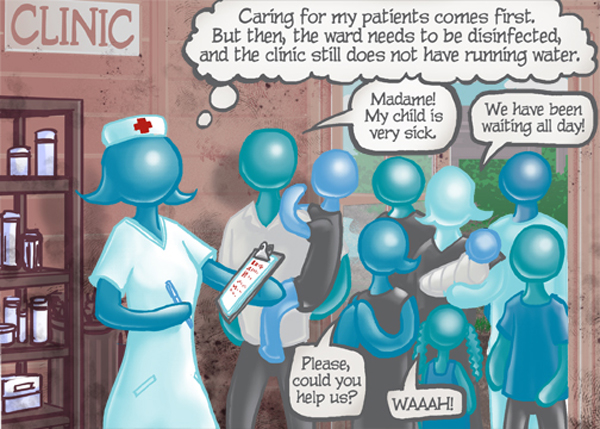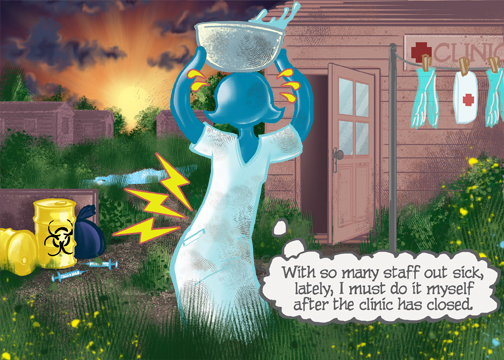
Saving Lives Shouldn’t Mean You Risk Your Own
- Login to post comments
-

Health workers shouldn’t have to put themselves at risk in order to do their jobs. But in fact, many frontline health workers face a wide range of occupational safety and health hazards—biological, physical, chemical, and psychosocial, as well as gender-based violence and discrimination.
Let’s take a look at one health worker—the nurse below on the left.

She’s facing a heavy workload and has many patients seeking her attention. The nurse is aware that the facility needs to be cleaned regularly to reduce risk of infection, but the janitor is absent. The lack of running water makes it even more challenging.

Our health worker is a dedicated employee—rather than leave when her shift is over, she takes time after the clinic is closed to do the cleaning. But the absence of her colleagues means more work for her, and she may not be able to do it all while taking measures to protect herself. Some health facilities lack proper disposal equipment, which can be dangerous for both the health workers and their patients.

Now it’s very late, and our health worker has to get herself home after dark. The road may not be safe, especially for a woman traveling alone. And when she gets home, she’ll have to do a lot of housework, meal preparation, and child care.
Then tomorrow she’ll do it all over again.
How can we help this nurse and other health workers like her? A new CapacityPlus technical brief, Ensuring a Positive Practice Environment: Occupational Safety and Health for Health Worker Productivity, outlines ways to make health workers’ safety a higher-level policy issue and shows how to create working environments that prioritize occupational health.
Just a few of the many hazards include:
- Lack of sterile equipment and proper waste management
- Exposure to bacteria, parasites, and blood-borne viruses such as HIV and hepatitis as well as communicable diseases such as tuberculosis, avian flu, and swine flu
- Physical strain and injury
- Bleach, lead, flammables, solvents, noxious vapors, and radiation
- Stress, fear caused by violence or verbal abuse, and depression.
The good news is that improving safety in the workplace can help address other service delivery issues and result in additional gains, from increased motivation and productivity to a stronger-functioning team.
To learn more, read the technical brief, and please let us know what you think. What are the occupational safety and health hazards faced by you or health workers you know? What is being done to reduce these hazards?
Related items:
Illustrations © CapacityPlus.


